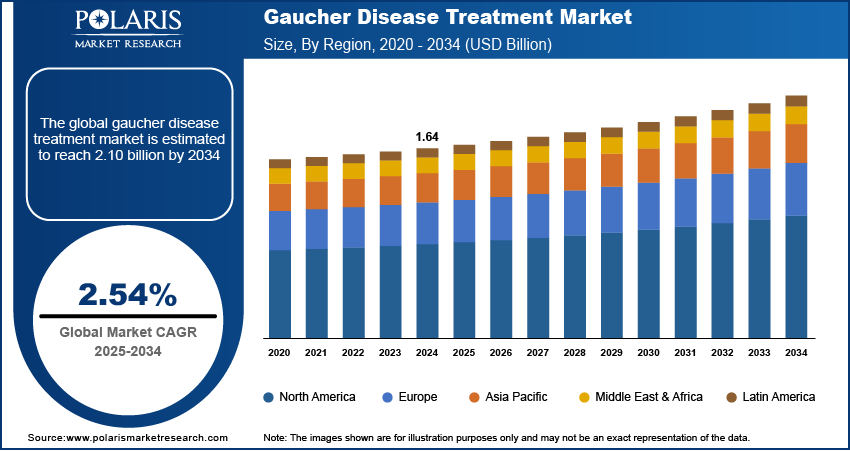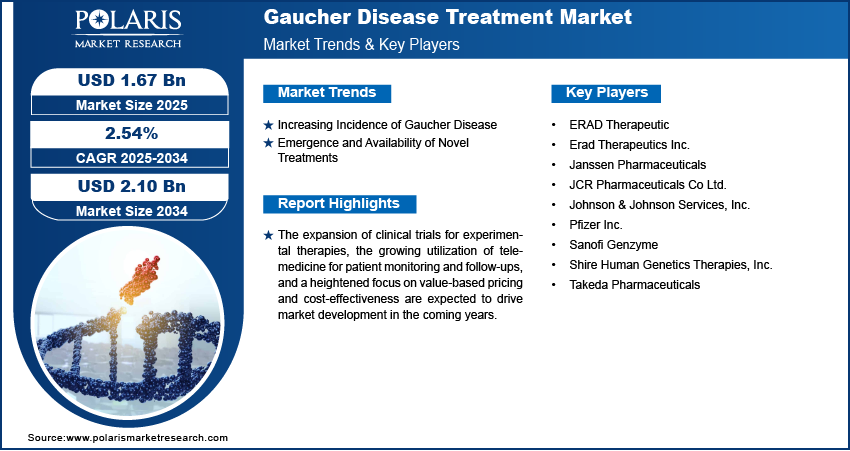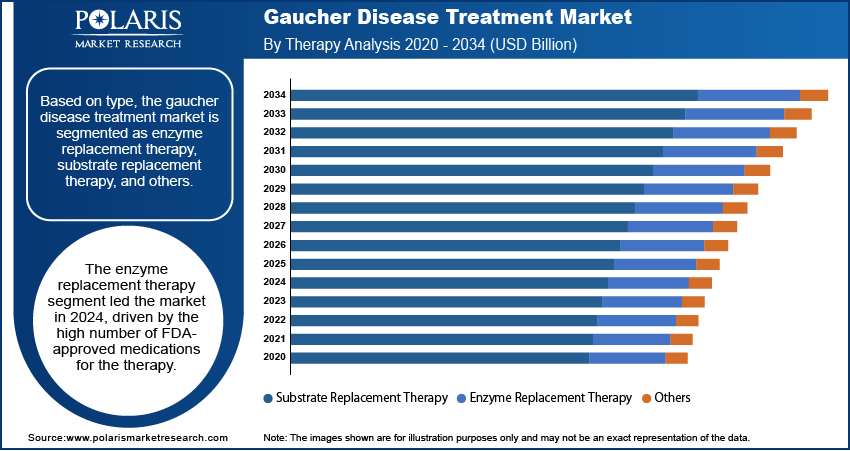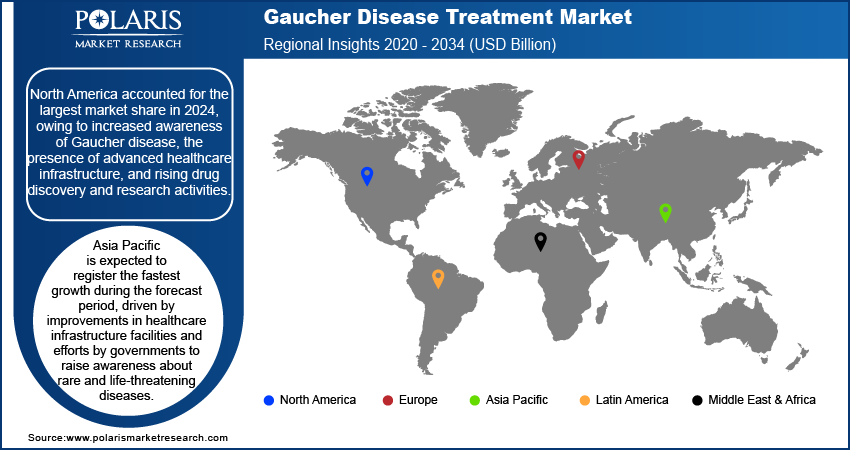
Gaucher Disease Treatment Market Size, Share, Trends, & Industry Analysis Report
: By Type (Type 1, Type 3, Type 2), By Therapy, By Distribution Channel, and By Region – Market Forecast, 2025–2034
- Published Date:Jun-2025
- Pages: 129
- Format: PDF
- Report ID: PM1514
- Base Year: 2024
- Historical Data: 2020-2023
Market Overview
The global Gaucher disease treatment market was valued at USD 2.14 billion in 2024 and is expected to register a CAGR of 2.8% during the forecast period. The growth is driven by rising healthcare spending and increasing strategic collaboration, acquisition, and partnership.
Gaucher disease is a rare genetic disorder caused by a deficiency of the enzyme glucocerebrosidase, leading to the accumulation of glucocerebroside in cells, particularly in the spleen, liver, bone marrow, and sometimes the brain. This causes symptoms such as enlarged organs, anemia, fatigue, bone pain, and neurological complications in severe cases. Treatment for Gaucher disease focuses on managing symptoms, replacing the missing enzyme, or reducing substrate accumulation. The primary treatment approaches include enzyme replacement therapy (ERT), substrate reduction therapy (SRT), and supportive care.
The rising number of rare disease cases across the world is driving the demand for Gaucher disease treatment. According to data published by the World Economic Forum in 2023, an estimated 400–475 million people have a rare disease globally. This widespread prevalence of rare diseases, including Gaucher, is creating the urgent need for effective management and treatment options, thereby driving demand for specialized medications such as those used to treat Gaucher disease. Moreover, the increase rare disease cases are driving regulatory agencies around the major regions to implement policies that incentivize the development of treatments for rare diseases, including Gaucher diseases, further driving the growth.

To Understand More About this Research: Request a Free Sample Report
Industry Dynamics
Increasing Healthcare Spending
The healthcare spending is increasing in major regions to improve access to advanced therapies, expand diagnostic capabilities, and raise awareness about rare disease diagnostics. Governments and private insurers are allocating more funds to healthcare systems, enabling hospitals and clinics to invest in diagnostic tools that identify Gaucher disease earlier and more accurately as early detection leads to a higher number of diagnosed cases, which increases the need for effective treatments. According to Economic Survey, the share of total health expenditure by the Government of India increased from 29.0% to 48.0% between FY15 and FY22. Expansion in healthcare budgets is allowing for the inclusion of expensive Gaucher therapies, such as enzyme replacement therapy (ERT) and substrate reduction therapy (SRT), in insurance coverage plans, fueling growth as patients who previously could not afford these expensive treatments now have access to them.
Pharmaceutical companies are also benefiting from increasing healthcare spending, as they receive more funding for research and development (R&D). This increase in funding for research and development is fueling these companies to accelerate clinical trials and virtual clinical trials, obtain regulatory approvals faster, and bring innovative therapies to market, thereby propelling the growth.
Increasing Strategic Collaboration, Acquisition, and Partnership
The strategic collaborations and partnerships among pharmaceutical companies, research institutions, healthcare providers, and patient advocacy groups are growing. These alliances are streamlining drug development, expanding patient access, and improving awareness, creating a more robust ecosystem for therapies. Biopharmaceutical companies partner with biotech firms to leverage advanced research, speeding up the discovery of novel treatments such as next-generation enzyme replacement therapies (ERTs) and gene therapies for the treatment of this rare disease. For instance, in January 2023, Neurocrine Biosciences, Inc., a biopharmaceutical company, and Voyager Therapeutics, Inc., a biotechnology company, announced the formation of a new strategic collaboration to advance multiple gene therapies for the treatment of neurological diseases such as Parkinson’s disease and other GBA1-mediated diseases, including Gaucher disease.
Academic institutions and hospitals are further playing a crucial role in disease treatment development by collaborating with drug manufacturers to conduct clinical trials and real-world studies on rare diseases. These partnerships generate critical data on treatment efficacy and safety, reassuring physicians and patients about newer therapies, thereby driving up demand.
Health systems and insurers are increasingly forming value-based partnerships with drug makers to improve patient access to high-cost therapies. Innovative payment models, such as outcome-based agreements, are making expensive Gaucher disease treatments more affordable for healthcare providers and patients, leading to industry expansion.
Acquisitions in the biopharmaceutical sector are accelerating growth by consolidating expertise, expanding reach, and improving R&D capabilities. Large pharmaceutical companies are acquiring smaller biotech firms specializing in rare diseases to gain access to innovative therapies for rare diseases and fast-track their development. For instance, in 2011, Sanofi acquired Genzymea, a US-based biotech firm specializing in treatments for rare diseases, to expand its presence in biotechnology and rare diseases such as Gaucher diseases. However, this acquisition agreement took place a decade ago, but it has a major impact on today’s growing Gaucher disease treatment landscape. Thus, due to aforementioned factors the Gaucher disease treatment industry is growing.

Segmental Insights
By Type Analysis
The segmentation, based on type, include type 1, type 3, and type 2. The type 1 segment dominated with the largest share in 2024. The rising patient advocacy is driving the type 1 drug adoption. These groups are providing educational resources, promoting awareness campaigns, and advocating for access to therapy, thereby bridging the gap between patients and providers. Patient advocacy is also expanding insurance coverage and government support for Gaucher disease treatment, which is driving the adoption of type 1 drugs such as ERT. For instance, the Government of India, through the National Policy for Rare Diseases (NPRD) 2021, provides financial assistance and treatment options for individuals suffering from rare diseases, including Gaucher disease. This policy includes a one-time financial grant of up to Rs. 50 lakhs (USD 60.24 thousand) per patient, along with treatment at designated centers-of-excellence (CoEs).
The type 3 segment is projected a record substantial growth, due to increasing awareness and diagnosis of neuronopathic Gaucher disease. Regulatory incentives for orphan drug development, such as fast-track designation and extended exclusivity, are encouraging pharmaceutical companies to invest in rare disease treatments. These incentives are further reducing financial risks and accelerating the commercialization of type 3 drugs. Strategic partnerships between biotech firms and academic institutions are also contributing to a growing pipeline of type 3 drugs, thereby driving the segment growth.
By Therapy Analysis
The segmentation, based on therapy, include enzyme replacement therapy (ERT), substrate reduction therapy (SRT), and other. The enzyme replacement therapy (ERT) segment accounted for a significant share in 2024, owing to the increasing awareness of rare diseases. Advocacy groups, genetic counselling initiatives, and newborn screening programs are improving early diagnosis rates. Earlier diagnosis is further leading to earlier treatment initiation, enhancing ERT results, and driving sustained demand. ERT therapy effectively reduces liver and spleen size, improves blood counts, and alleviates bone complications. Patients usually notice significant clinical improvement within six to twelve months of beginning treatment. ERT modifies the disease process itself, which makes it crucial in Gaucher disease management, especially for type 1 Gaucher disease, the most common and non-neuropathic form. ERT does not cross the blood-brain barrier, limiting its effectiveness in neuronopathic types (types 2 and 3).
The substrate reduction therapy (SRT) segment is projected to reach substantial revenue by 2034. Patient preference for oral therapies drives the growing adoption of SRT in Gaucher disease treatment . Enzyme replacement therapy requires biweekly intravenous infusions that can be uneasy for patients. SRT offers a convenient, noninvasive oral route that improves adherence and enhances quality of life. This mode of delivery is becoming especially attractive in regions with limited infusion infrastructure or where frequent hospital visits are challenging. Healthcare providers are increasingly favoring SRT for patients who develop immune reactions or antibodies against ERT products. In these cases, switching to SRT provides an effective means to control disease symptoms without invoking adverse immunologic responses. Additionally, advancements in pharmacogenomics are supporting personalized SRT treatment based on CYP2D6 genotype. This precision medicine approach enables better outcomes and expands the eligible patient population.

Regional Analysis
Gaucher Disease Treatment Market in North America
The North America Gaucher disease treatment market accounted for 40.42% global revenue share in 2024 due to high awareness, advanced healthcare infrastructure, and supportive government policies. The region benefits from early diagnosis and access to innovative therapies. Major pharmaceutical companies are based across the region, which helps in drug development and distribution. Additionally, the presence of patient advocacy groups boosts research and funding. Additionally, the rising focus on rare disease initiatives strengthens the landscape, thereby driving the industry growth in the region.
Gaucher Disease Treatment Market in US
The US Gaucher disease treatment market is expected to witness significant growth due, the presence of advanced medical facilities and an active research ecosystem. The FDA plays a major role in fast-tracking rare disease drugs, which is encouraging innovation. High healthcare spending, insurance coverage, and access to specialists are supporting early treatment. The presence of top biotech firms such as Sanofi and Pfizer ensures supply and development of advanced therapies. Patient support programs also help reduce treatment costs and improve adherence, thereby driving the growth in the region.
Gaucher Disease Treatment Market in Asia Pacific
The Aisa Pacific Gaucher disease treatment market accounted for 18.97% share in 2024. The expansion of diagnostic and genomic testing capabilities is shaping the regional outlook as early detection of Gaucher disease is becoming more feasible as genomic technologies become more affordable and integrated into clinical workflows. Laboratories in APAC are increasingly equipped to handle enzyme assays and genetic sequencing, which are crucial for confirming Gaucher disease, thereby reducing diagnostic delays and supporting timely intervention. According to the January 2025 report by India's Ministry of Science & Technology, the FeED framework and IBDC portals are providing global researchers access to 10,000 whole genome samples from diverse Indian populations. Moreover, the region is witnessing rising collaboration between international pharmaceutical companies and local health institutions. For instance, in May 2023, the National Gaucher Foundation (NGF) collaborated with the Greenwood Genetic Center (GGC), a genetic diagnostics and research lab, to support NGF’s Global Diagnostic Initiative for improved genetic testing and clinical services. These partnerships are instrumental in facilitating knowledge transfer, establishing treatment protocols, and launching targeted educational campaigns for both clinicians and patients. This collaborative approach is further boosting the introduction of enzyme replacement therapies and substrate reduction therapies that are tailored to local healthcare delivery models, thereby driving the growth of the region.
Gaucher Disease Treatment Market in Japan
The Japan Gaucher disease treatment market is expected to reach USD 112.91 million by 2034, due to advanced healthcare systems and proactive government policies on rare diseases. The country has a national registry for rare disorders, which helps in early diagnosis and monitoring. Approved enzyme replacement therapies are available, and treatments are often covered under Japan’s universal health insurance system, reducing patient burden. Additionally, research institutions and pharmaceutical companies are actively involved in developing new treatments and participating in global clinical trials, thereby driving the growth in the region.

Key Players & Competitive Analysis Report
The Gaucher disease treatment market remains highly competitive, with multiple therapies targeting various subtypes of the condition, including type 1, type 2, and type 3. Participants focus on enzyme replacement therapies (ERTs) and substrate reduction therapies (SRTs), both of which serve as cornerstone treatments. Developers continue to invest in novel formulations and oral therapies that offer improved patient compliance and potentially target neurological symptoms, particularly in neuronopathic Gaucher disease. Clinical trials aim to demonstrate superior efficacy, longer half-life, and enhanced ability to cross the blood-brain barrier. Companies prioritize strategic licensing, collaborations, and regional expansion to secure industry share and strengthen product pipelines. Biosimilar development introduces further competition, particularly in regions with cost-sensitive healthcare systems.
Key Players
- Amicus Therapeutics, Inc.
- CANbridge Life Sciences Ltd.
- Eli Lilly and Company
- Johnson & Johnson, Inc.
- Lingyi Biotechnology
- Protalix Biotherapeutics Inc.
- Sanofi
- Spur Therapeutics
- Takeda Pharmaceutical
Industry Developments
March 2025: Spur Therapeutics launched FLT201, an investigational gene therapy, to ease symptoms and potentially reverse Gaucher disease type 1. Designed to restore glucocerebrosidase enzyme production via a one-time intravenous infusion, FLT201 aims to reduce fatty molecule accumulation and has completed Phase 1/2 trials, with Phase 3 planned.
July 2024: Spur Therapeutics announced positive early data for FLT201, its gene therapy for Gaucher disease. The company completed enrollment for Phase I/II trials and planned Phase III studies for 2025. The therapy demonstrated substantial reductions in disease biomarkers and received RMAT and PRIME designations from FDA and EMA.
Gaucher Disease Treatment Market Segmentation
By Type Outlook (Revenue, USD Billion, 2020–2034)
- Type 1
- Type 3
- Type 2
By Therapy Outlook (Revenue, USD Billion, 2020–2034)
- Enzyme Replacement Therapy (ERT)
- Substrate Reduction Therapy (SRT)
- Others
By Distribution Channel Outlook (Revenue, USD Billion, 2020–2034)
- Hospital Pharmacies
- Retail Pharmacies
- Online Pharmacies
By Regional Outlook (Revenue, USD Billion, 2020–2034)
- North America
- US
- Canada
- Mexico
- Europe
- Germany
- France
- UK
- Italy
- Spain
- Netherlands
- Russia
- Rest of Europe
- Asia Pacific
- China
- Japan
- India
- Malaysia
- South Korea
- Indonesia
- Australia
- Vietnam
- Rest of Asia Pacific
- Middle East & Africa
- Saudi Arabia
- UAE
- Israel
- South Africa
- Rest of Middle East & Africa
- Latin America
- Brazil
- Argentina
- Rest of Latin America
Gaucher Disease Treatment Market Report Scope
|
Report Attributes |
Details |
|
Market Size in 2024 |
USD 2.14 Billion |
|
Market Size in 2025 |
USD 2.18 Billion |
|
Revenue Forecast by 2034 |
USD 2.81 Billion |
|
CAGR |
2.8% from 2025 to 2034 |
|
Base Year |
2024 |
|
Historical Data |
2020–2023 |
|
Forecast Period |
2025–2034 |
|
Quantitative Units |
Revenue in USD Billion and CAGR from 2025 to 2034 |
|
Report Coverage |
Revenue Forecast, Competitive Landscape, Growth Factors, and Industry Trends |
|
Segments Covered |
|
|
Regional Scope |
|
|
Competitive Landscape |
|
|
Report Format |
|
|
Customization |
Report customization as per your requirements with respect to countries, regions, and segmentation. |
FAQ's
The global market size was valued at USD 2.14 billion in 2024 and is projected to grow to USD 2.81 billion by 2034.
The global market is projected to register a CAGR of 2.8% during the forecast period.
North America dominated the market share in 2024.
A few of the key players in the market are Amicus Therapeutics, Inc.; CANbridge Life Sciences Ltd.; Eli Lilly and Company; Johnson & Johnson, Inc.; Lingyi Biotechnology; Protalix Biotherapeutics Inc.; Sanofi; Spur Therapeutics; and Takeda Pharmaceutical.
The type 1 segment dominated the market share in 2024.
The substrate reduction therapy segment is expected to witness the fastest growth during the forecast period.
